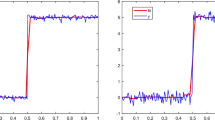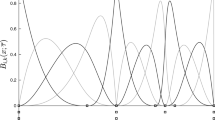Abstract
This article describes a new approach to estimate F 0 curves using B-spline and Spline models characterized by a knot sequence and associated control points. The free parameters of the model are the number of knots and their location. The free-knot placement, which is a NP-hard problem, is done using a global MLE (Maximum Likelihood Estimation) within a simulated-annealing strategy. Experiments are conducted in a speech processing context on a 7000 syllables french corpus. We estimate the two challenging models for increasing values of the number of free parameters. We show that a B-spline model provides a slightly better improvement than the Spline model in terms of RMS error.
Preview
Unable to display preview. Download preview PDF.
Similar content being viewed by others
References
Raux, A., Black, A.: A unit selection approach to f0 modeling and its application to emphasis. In: Proc. ASRU Conf., pp. 700–703 (2003)
Hirst, D., Cristo, A.D., Espesser, R.: Levels of representation and levels of analysis for the description of intonation systems. In: Horne, M. (ed.) Prosody: Theory and Experiment, vol. 14, pp. 51–87. Kluwer Academic Pusblisher, Dordrecht (2000)
Taylor, P.: Analysis and synthesis of intonation using the tilt model. J. Acoust. Soc. America 107, 1697–1714 (2000)
Sakai, S., Glass, J.: Fundamental frequency modeling for corpus-based speech synthesis based on statistical learning techniques. In: Proc. ASRU Conf., pp. 712–717 (2003)
Barbot, N., Boeffard, O., Lolive, D.: F0 stylisation with a free-knot b-spline model and simulated-annealing optimization. In: Proc. Eurospeech Conf., pp. 325–328 (2005)
Ingber, L.: Adaptive simulated annealing (asa): lessons learned. Control and Cybernetics 25, 33–54 (1996)
Mouline, S., Boeffard, O., Bagshaw, P.: Automatic adaptation of the momel f 0 stylisation algorithm to new corpora. In: Proc. of ICSLP (2004)
Author information
Authors and Affiliations
Editor information
Editors and Affiliations
Rights and permissions
Copyright information
© 2006 Springer-Verlag Berlin Heidelberg
About this paper
Cite this paper
Lolive, D., Barbot, N., Boëffard, O. (2006). Comparing B-Spline and Spline Models for F0 Modelling. In: Sojka, P., Kopeček, I., Pala, K. (eds) Text, Speech and Dialogue. TSD 2006. Lecture Notes in Computer Science(), vol 4188. Springer, Berlin, Heidelberg. https://doi.org/10.1007/11846406_53
Download citation
DOI: https://doi.org/10.1007/11846406_53
Publisher Name: Springer, Berlin, Heidelberg
Print ISBN: 978-3-540-39090-9
Online ISBN: 978-3-540-39091-6
eBook Packages: Computer ScienceComputer Science (R0)




